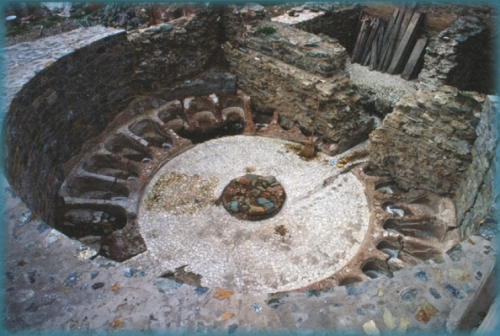Monika Truemper spent her summer on the sunny Greek isle of Delos — but not so she could soak up some rays. She was there to clean the ancient latrines.
“It was sometimes disgusting,” she says.
The archaeologist scrubbed her way through some one hundred ancient Greek lavatories dating from the second century BC, clearing away plants and debris that had built up since the sites were first excavated decades ago.
As she examined the architecture of the structures, drew floor plans, and took photos, she found that the ancient Greeks weren’t exactly shy. Public privies on Delos could seat twenty to thirty people at once, all along a wooden bench situated over a deep drainage trench. Water was scarce, she says, but they sometimes used buckets of it to flush the toilets.
Other archaeologists dream of studying the spectacular ancient Greek sites, Truemper says — the grand temples and theatres. “I’m more interested in their daily life,” she says. Toilets and bath houses, for instance.
It was the ancient Greeks, Truemper says, who turned bathing into more than just a way to clean the grime off your feet and hands.
During the Hellenistic Period — around the third century BC — public and private bathing facilities began popping up all over the Greek world, even right next to rivers and the sea. The Greeks bathed mainly to clean themselves, Truemper says, and later for relaxation. But they also used the bath houses as remedies for ailments, as part of religious ceremonies, for massage, and sometimes for erotic encounters. “Greek culture was obsessed with the body, especially with beautiful, young bodies,” Truemper says. “It was important to keep the body clean, to oil and perfume it, and to groom it.”
And while they were at it, they even rigged the bath houses so that they could wash in luxuriously warm water.
In Hot Water
Some think that the Romans were the first culture to bathe for pleasure. And while the Romans did improve upon a lot of the Greeks’ inventions, Truemper says, “many of what we usually consider to be Roman features, such as bathing communally and for relaxation, were actually already present in Greek bathing culture. And then the Romans made it perfect.”
Before the third century BC, most bathers in the Greek world — which spread across southern Italy to Egypt to Turkey — used what is called a sitz-bathtub, Truemper says. “They had to sit crouched and all they could do was shower themselves with either cold or hot water. This was not a very comfortable, relaxing bath. It’s more of a cleansing bath.”
But as early as the third century BC, Truemper says, people began experimenting with different bathing forms, “and they were relaxing. You had hot water tubs where you could actually take an immersion bath. Some were individual, and some were communal, which means that you had a large pool that you could use with other people. This was a completely new concept.”
Monika Truemper is an assistant professor of classical archaeology in the College of Arts and Sciences. She has received funding for her research from the Alexander von Humboldt Foundation and from UNC’s University Research Council and Office of the Executive Vice Chancellor and Provost.




